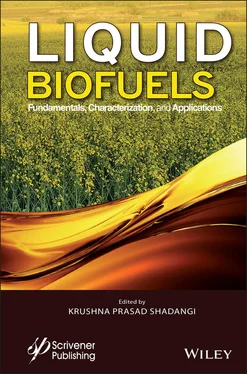I also thank Wiley-Scrivener for the cooperation in developing this comprehensive book.
Dr. Krushna Prasad ShadangiAssistant Professor Department of Chemical Engineering Veer Surendra Sai University of Technology, Burla, Sambalpur, Odisha, India
1
Introduction to Biomass to Biofuels Technologies
Ezgi Rojda Taymaz, Mehmet Emin Uslu and Irem Deniz*
Bioengineering Department, Faculty of Engineering, Manisa Celal Bayar University, Muradiye-Manisa, Turkey
Abstract
Biofuels are renewable, environmentally friendly, alternative fuels suitable for use as heat, power and alternative engine fuel, important for the socioeconomic development of countries, resource diversity and supply security. Applications of liquid-solid-gas biofuels obtained from biomass in energy sources are increasing rapidly. The bioenergy sector has a rather complex structure due to the diversity of potential raw materials and technical ways to convert biomass into energy. Sixty percent of the biomass is derived from agricultural waste, and various conversion techniques are applied to these organic wastes for bioenergy production. The most important alternative biofuels based on biomass can be classified as bioethanol, biodiesel, biogas, bio-methanol, bio-methyl ether and bio-oil. The most common biofuels are bioethanol and biodiesel. Biofuels have been found to increase its usability due to being based on renewable biological resources and non-toxic, having a good biodegradability, causing very low emissions when burned and being environmentally friendly. This chapter investigates biomass resources and biofuel technologies in a bio-refinery concept.
Keywords:Biomass, biofuel, bio-refinery, conversion techniques, energy, liquid biofuels
Non-fossil biomass can be used for bioenergy production. This bioenergy is called biomass energy and is defined as the conversion of energy from the sun by plants. Its principle is to use the energy stored in the plant in its transformed form when needed. Biomass energy is examined in two groups as classical and modern. Classical biomass energy consists of firewood, plant and animal residues obtained from conventional forests. The main character of the use of classical biomass energy is that the energy from the biomass material is obtained through various combustion tools and direct combustion techniques from primitive to developed ones. Modern biomass resources are listed as energy forestry products, forest and wood industry wastes, energy agriculture, vegetable and animal wastes in the agricultural sector, urban wastes, and agriculture-based industrial wastes [1].
Biomass materials are transformed into biofuels after pre-preparation and conversion. Biofuels can be used for heat and electricity production. Biofuel use ranges from large central power station to vehicles. Modern biomass energy techniques are based on transforming the material so that the physical condition remains constant and/or changed. Biomass is divided into low biomass techniques and high biomass techniques. Low biomass techniques are direct combustion, anaerobic decomposition, fermentation-distillation processes. High biomass techniques consist of pyrolysis, hydrogasification, acid hydrolysis, and biological hydrogen production processes. Modern biomass energy is a sustainable energy source, in full compliance with the environment. Biofuels are the general names of gas, liquid and solid products obtained by passing agricultural products, wood, animal, plant and urban waste through various biochemical and/or thermochemical conversion processes. Gas biofuels; bio-hydrogen, biogas, synthetic gases, solid biofuels; wood coal, bio-char, bio-pellet, bio-bricket, liquid biofuels; bioethanol, biodiesel, bio-methanol, bio-methyletheter and vegetable oils [1, 2].
It is possible to produce both energy and new chemicals using different methods from biomass. Biogas and ethanol can be produced by fermentation in anaerobic environment [3]. Gas fuel and activated carbon are produced by pyrolysis from wastes with a high percentage of solid with thermal decomposition. Synthetic fuel (syngas) production can be made by hydrogasification and hydrogenation. Heat energy and electricity are produced by burning garbage and solid wastes directly with air. Organic fertilizer is produced as a result of composting of garbage and animal feces [1].
1.2 Lignocellulosic Biomass and Its Composition
Various agricultural by-products and vegetal wastes that are released to the environment as solid wastes can be considered as biomass sources. Such substances show similarities with wood in terms of their general properties and chemical structures and are called lignocellulosic biomass. Lignocellulosic biomass has a rather complex polymeric structure. The plant cell (from outside to inside) consists of pectin, cellulose, ligninhemicellulose, and soluble stoplasmic compounds. Intracellular components are mainly sugars, starch, proteins, pectin and lipids. Lignocellulosic materials are an important source of raw materials because these components can be separated by hydrolysis and extraction [4, 5].
The lignocellulosic materials that make up 50% of the total biomass in the world are not suitable for consumption as direct food and are made up of plant sources. Basically, there are three basic polymers: hemicellulose (C 5H 8O 4) n, cellulose (C 6H 10O 5) nand lignin [C 9H 10O 3) (OCH 3) 0.9-1.7] n[4]. Typically, biomass contains 40-60% cellulose, 20-40% hemicellulose and 10–25% lignin. Extracts and minerals in lignocellulose are up to 10% of the weight of dry biomass. Other substances in the lignocellulose (extractives) are organic solutions or water-soluble substances, which make up a very small part (1-5%) of the lignocellulosic substance [6].
The cell walls of plants contain lignocellulose. If the lignin is removed, the polysaccharide derivative remains. Polysaccharides in the plant cell are also called halocellulose. Halocelluloses consist of celluloses and hemicelluloses. If halocellulose is hydrolyzed, C6 and C5 sugars, uronic acids and acetyl groups are obtained. C6 sugars are glucose, mannose and galactose. C5 sugars are mainly xylose and arabinose. The ratio of each compound varies depending on the plant source [7].
The main components of lignocellulosic natural sources are cellulose, hemicelluloses, lignin, extractives and inorganics [8]. Cellulose in nature is polysaccharides such as various starch, pectin, and hemicellulose. Hemicelluloses are galactose, mannose, xylose, arabinose and other sugars; they contain polymers and heteropolymers of uronic acids. In addition cellulose in nature exists as a mixture of cellulose-lignin [9, 10].
In the biosphere, which we call the world of living things, approximately 27x10 10tons of carbon is attached to living organisms and more than 99% of it is found in vegetable material. Approximately 40% of the carbon in plants comes from cellulose. In this regard, cellulose is the most abundant natural polymer on earth, and it has a wide spread from primitive plants (algae, moss, etc.) to highly organized plants (woods) and some bacteria [11, 12]. Cellulose is one of the most important structural polysaccharides that are found in the plant world and have the simplest structure and also located in the cell wall structure [13].
Cellulose is the most common polymer on earth which is a linear syndiotactic (alternative spatial arrangement) of the glucose polymer bonded by Β-(1 → 4)-glycosidic bonds. The size (degree of polymerization) of the cellulose molecule varies depending on the presence of less than 500 glucose units in each molecule in the secondary wall located on the wall of the plant cell [9]. Cellulose chains are formed by combining thousands of glucose units and these chains have hydrogen and Van der Waals bonds [14].
Читать дальше












